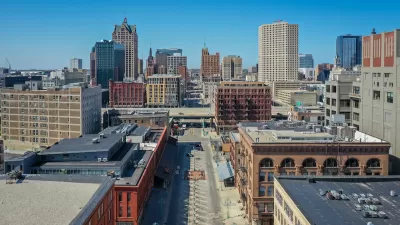A federal court found that the Wisconsin DOT uses specious traffic projections to justify the $146 million widening of Highway 23. The state must now either perform verifiable forecasting or scrap the expansion plans.
State departments of transportation all over the country use specious traffic projections to justify hugely expensive road widening projects. That’s how you end up with the graph below—showing how DOTs continued to forecast traffic growth year after year, even as driving stagnated.
Aggregate traffic projections from the nation’s state and regional transportation agencies have become increasingly divorced from reality. (Source: SSTI)
Wisconsin DOT is perhaps the most notorious manipulator of traffic forecasts. Fortunately, Wisconsin also has a strong network of organizations holding the DOT's feet to the fire and dragging it to court if need be.
Today, 1,000 Friends of Wisconsin Executive Director Steve Hiniker shares news of a major legal victory. A federal court sided with the organization in a suit against WisDOT that challenged the traffic data used to justify the $146 million widening of Highway 23:
According to the ruling, the Wisconsin DOT failed to justify the amount of traffic it projected as likely to use the road in the future. The Court ruled that the project is ineligible for federal funding until documented accurate traffic forecasts can be made that justify expanding the highway. The state can now either go back to the drawing board and do verifiable forecasting or scrap the expansion plans. The ruling does not stop the state from building the project using only state funds.
“We encourage the DOT to immediately make safety improvements along Highway 23 that could always have been done without expanding the highway to 4 lanes,” added Hiniker.
“We call on the legislature to stop funding any road expansion project that has not already begun construction until updated, accurate and verifiable traffic forecasts can be made. The state cannot afford to spend billions of dollars on highway projects that are not justified by accurate data,” concluded Hiniker.
This case could have dramatic ramifications for other highway building plans in the state. Critics of DOT building plans have questioned a number of projects based on faulty traffic projections – including the proposed almost billion dollar expansion of the I-94 corridor near Miller Park in Milwaukee.
FULL STORY: Federal Court: Wisconsin Uses Bogus Traffic Data to Justify Highways

Planetizen Federal Action Tracker
A weekly monitor of how Trump’s orders and actions are impacting planners and planning in America.

Congressman Proposes Bill to Rename DC Metro “Trump Train”
The Make Autorail Great Again Act would withhold federal funding to the system until the Washington Metropolitan Area Transit Authority (WMATA), rebrands as the Washington Metropolitan Authority for Greater Access (WMAGA).

The Simple Legislative Tool Transforming Vacant Downtowns
In California, Michigan and Georgia, an easy win is bringing dollars — and delight — back to city centers.

The States Losing Rural Delivery Rooms at an Alarming Pace
In some states, as few as 9% of rural hospitals still deliver babies. As a result, rising pre-term births, no adequate pre-term care and "harrowing" close calls are a growing reality.

The Small South Asian Republic Going all in on EVs
Thanks to one simple policy change less than five years ago, 65% of new cars in this Himalayan country are now electric.

DC Backpedals on Bike Lane Protection, Swaps Barriers for Paint
Citing aesthetic concerns, the city is removing the concrete barriers and flexposts that once separated Arizona Avenue cyclists from motor vehicles.
Urban Design for Planners 1: Software Tools
This six-course series explores essential urban design concepts using open source software and equips planners with the tools they need to participate fully in the urban design process.
Planning for Universal Design
Learn the tools for implementing Universal Design in planning regulations.
Smith Gee Studio
City of Charlotte
City of Camden Redevelopment Agency
City of Astoria
Transportation Research & Education Center (TREC) at Portland State University
US High Speed Rail Association
City of Camden Redevelopment Agency
Municipality of Princeton (NJ)





























